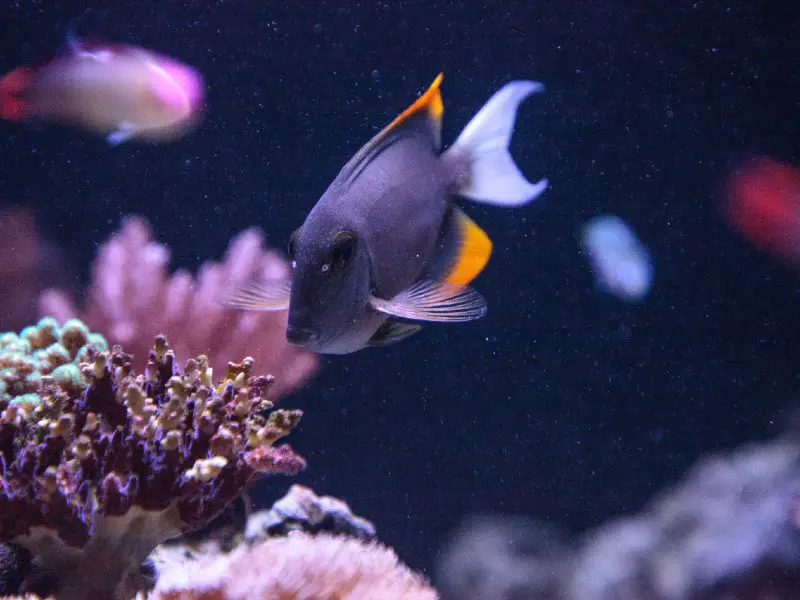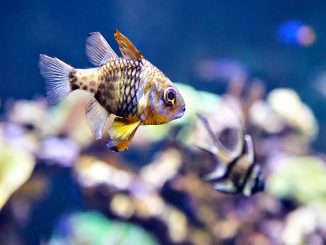
Tomini Tang is often called Tomini Surgeonfish and is in the genus Ctenochaetus. It isn’t a rare tang species and is favored amongst fish-keeping enthusiasts for its small size, even as an adult fish.
If you want a fish that has a long life span and quirky personality, Tomini Tangs are great fish to go for. Choosing reef-safe fish for your aquarium can be a challenge, but the Tomini Tang is a fish that fits perfectly into a reef environment.
This article will cover everything you need to know about Tomini Tang so that you can make sure that they are completely suitable for you. Read through the information in this post to find out their basic care needs, how to breed them, what their dietary needs are, and much more. Enjoy!
TABLE OF CONTENTS
Tomini Tang Facts & Overview

| Category | Rating |
| Care Level: | Moderate |
| Temperament: | Not tolerant of new tank mates, but settle down over time. Avoid keeping them with other non-related tangs |
| Color Form: | Brown body with yellow, blue, and white highlights |
| Lifespan: | Over 5 years |
| Size: | 6 inches |
| Diet: | Omnivore |
| Family: | Tangs |
| Minimum Tank Size: | 70 gallons |
| Tank Set-Up: | Reef tank |
| Compatibility: | Peaceful but may bully species introduced after them |
Tomini Tang has quite a few street names. You might have heard them being referred to as Bristletooth Tomini Tang, Tomini Surgeonfish, and Flame Fin Tang. Its scientific name is Ctenochaetus Tominiensis, which is quite the mouthful, so we will stick to Tomini Tang for the purpose of this article.
There are a whopping 38 species of tang fish and the majority of them are found in the Indo-Pacific Oceans, with a few species scattered in the Atlantic Ocean. They feed on algae in the wild, and nori is their favorite food in captivity. I suggest letting your fish graze on their food as and when they want to throughout the day, much as they would in the wild.
You can expect to pay anywhere from $60 to $80 for a Tomani Tang fish, which isn’t cheap. Larger Tang species can cost up to $250 per fish.
Typical Behavior
Tomini Tang is generally a very calm fish that keeps itself to itself. They don’t like sharing a tank with other Tang species, so avoid putting multiple Tang breeds into one aquarium; otherwise, you are asking for trouble.
If you are planning your aquarium setup, make sure that the Tomini Tang is the last fish you introduce into your aquarium. They can be a little feisty with new fish that are introduced after them, but they should calm down after a few days.
Appearance
Tomini Tang has a brown body with yellow and blue fins. It has a white underbelly that will get darker and eventually turn brown as the fish ages. Mature fish have a very distinct blue tail, with bright yellow anal fins and dorsals.
These fast and furious fish stay rather small. You can expect an adult Tomini Tang fish to grow up to six inches long, but most of the time, adult fish are smaller than that.
Some Tang species can grow up to 30 cm long and weigh over 600 grams. This is not the case for our little Tomini Tang. it is very easy to get confused between Tang species, even though they all look very different.
Habitat and Tank Conditions

Tomini Tang are most commonly found in the Solomon Islands, Western Central Pacific, Indo Pacific, and Fiji. They are tropical fish that are also brilliant tank mates for reef tanks.
This is your chance to get decorating and accessorizing! Tomini Tang loves feeding on algae that grow amongst rocks in the fish tank. They are grazing fish, which means that they ideally like to pick at food throughout the day, and keeping rocks and vegetation in the tank is the best way to let your fish do this.
Tank Conditions
It is vital to keep your fish tank’s condition in line with the fish you are keeping as close as possible to meet ideal tank conditions. Choosing compatible fish and plants is important to ensure none of your tank mates deteriorate due to non-ideal conditions.
Tomini Tang should be kept in water with a pH level of between 8.1 to 8.4. The water temperature should never drop lower than 75 ° F and avoid letting the tank reach temperatures higher than 80° F.
These fish need a lot of tank space as they are eager swimmers, so don’t overcrowd the aquarium with too many fish, plants, and accessories. Keep the lighting moderate as these fish don’t appreciate bright lighting.
What Size Aquarium Do They Need?

As I mentioned above, Tomini Tang is a speedy little fish that swims around the tank a lot. Ideally, you want to keep them in a 120-gallon fish tank; however, this might not be possible.
As long as the aquarium isn’t overcrowded, Tomini Tang can live happily in 70-gallon fish tanks. Some tank enthusiasts keep their fish in 40-gallon fish tanks, which, although this is technically ok, your fish won’t be as happy and healthy as they should be.
Fish that live to their five-year life expectancy are usually kept in fish tanks no smaller than 120 gallons. The better your fish’s quality of life, the longer it will live, and the calmer your fish will be in the tank.
How Many Can be Kept Per Gallon?
You should keep about three healthy Tomini Tang fish in a 120-gallon tank. If you go for the smallest recommended fish tank of 70 gallons, keep no more than two Tangs in the tank together.
Tank Mates
Tomini Tangs are compatible with clownfish, angelfish, hawkfish, pufferfish, gobbies, eels, and many other reef fish. The most important thing to remember when keeping a mixture of fish species in a tank together is to go for fish with similar temperaments.
Can You Keep Tomini Tang Together?
You can keep Tomini Tang in the same fish tank, but this is only recommended if the fish have plenty of space to swim around the tank. Never keep more than three or four in an aquarium together, especially if they are sharing a tank with other Tang species.
Diet
Seaweed and algae are Tomini Tang’s favorite dishes. Although these fish are omnivores in the wild, you will find them nibbling on meaty fish food in an aquarium if it shares a tank with meat-eating fish. Tomini Tangs graze on food throughout the day in their natural habitat, so setting up a feeding schedule like this is better for your fish than set feeding times.
You should avoid intentionally feeding your fish meat and try to keep their diet as close to what they will wind in the wild as possible. This might mean you need to keep Tomiri Tang in an omnivore-only fish tank.
Care
Caring for your Tomini Tang fish properly is vital if you want them to live to their five-year life expectancy. Make sure you give them live rock to graze on and feed them algae and seaweed regularly.
Avoid keeping them in overcrowded fish tanks as this can make the fish very distressed and even depressed. If you see your fish swimming around frantically, you should check that the pH level of the water, the temperature, and the chemical makeup is within the correct range.
Regular standard fish tank maintenance is required in a Tomini Tang tank. As long as the tank is kept clean and partial water changes are done on time, the fish should stay happy and healthy.
Breeding

It is hard to determine the sex of the fish by looking at external characteristics. These fish are group spawners and open water egg scatterers. Breeding Tomini Tang in a community fish tank is very difficult and almost impossible.
If you want to make breeding these fish easier, you should put Tomini Tang into a separate breeding tank and alter the conditions accordingly. Increasing the temperature slightly prompts and encourages breeding.
Setting up a breeding tank appropriately for group spawning fish is very important, especially when the eggs are laid in open water. Your fish will not ‘get in the mood’ if the tank is not spot on.
Are Tomini Tang Suitable for Your Aquarium?
What do you think of Tomini Tang after reading this article? You can trust these bright and lively fish to keep you on your toes as they are speedy fish with heaps of personality.
If you already have an aquarium full of chilled-out fish, and you want to add a bit of excitement and speed to your tank, these are great tank mates to go for. I suggest keeping these fish if you have some tank experience and you are not new to caring for fish and large tanks.








Be the first to comment